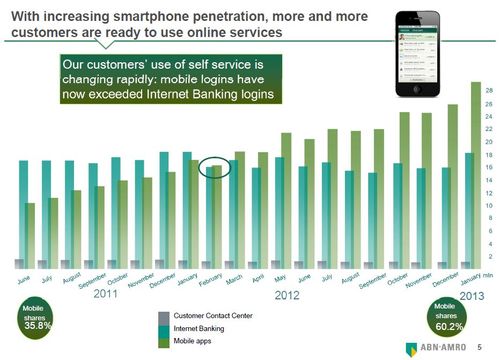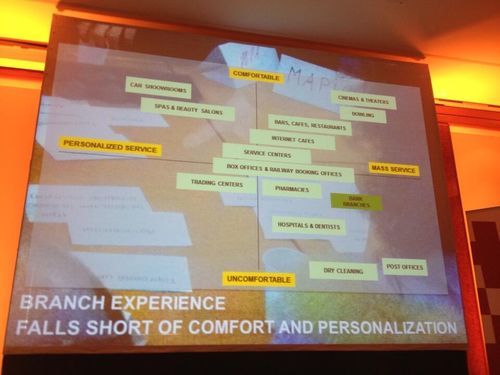
A final presentation from EFMA week that I need to reference
before moving on came from Eric Mackor, Head of Channel Development at the Netherlands
Retail Bank ABN AMRO (as opposed to the transaction bank part of ABN AMRO that
was acquired by the Royal Bank of Scotland).
He talked about the changing dynamics of channel usage
within the bank and noted to start with that mobile is now their dominant
contact point with customers, with over a million interactions per day,
representing three out of every five customer contacts and far outweighing
internet and call centre services.
This statistic is corroborated by other presentations referenced
during the week, bearing in mind my two favourite statistic points were:
It took 13 years to get two million customers using Internet
banking; it took just two months to reach that number for mobile banking.
[Barclays Bank]
It took 10 years to get twenty million contacts per month
through Internet banking. It took 18 months for mobile.
[Société Générale]
Therefore it’s not surprising that over half of all the bank
branches in the Netherlands have closed in the past decade.

Not surprising, but it does beg the question as to what the branch
is there for today?
For example, Eric’s next slide had the following title:
Brutal fact: on a weekday a small branch welcomes 20
customers; and 27 customers withdraw cash at the indoor ATM
And each of these small branches has an average of two staff
servicing twenty customers in an eight hour day. That’s just over one customer served per
staff member per hour. That’s either amazingly
personal service or an awful lot of thumb twiddling during the day waiting for
something to happen.
The punch line of Eric’s presentation however, is that although
the bank can see more and more ways to service the customer out of branch, the
customer’s won’t let the branch go.
A slide that explained their customer types showed five
distinct categories of consumer:
- Intensive channel users who use all channels regularly;
- Personal contact seeking customers, who want advice and
face-to-face service; - Self-directed people who think they can do everything
themselves; - Passive hybrid customers who only talk to the bank when
they have to; and - Inactive channel users who never talk to the bank via any channel
The last two categories represent the least profitable and smallest sector for the bank, whilst the first two are the targeted ‘mass affluent’,
whilst the mid-category is the majority of the client base.
Amazingly, the first three categories all answered the
question: I prefer to discuss more
serious banking issues in person (89%) and in case of problems, I want to be able to go into a branch and speak to
someone (94%).
In other words, although the bank knows the branch is dead, the
customer does not. This is why ABN are following
the strategy that I’ve blogged about before,
as in consolidating branch operations into super branch centres and automating
more and more in remote branch machines.
There was lots of other fun stuff to report from the EFMA
conference too, such as customers enjoy visiting bank branches about as much as
getting a tooth pulled out or being intimately analysed by their doctor:

Slide from presentation
by Barbesino Paolo of Unicredit and text is a variation of a tweet by Mark
Pickens
However, I cannot dedicate my blog more to this one subject
as there’s so much more to talk about, like the second Financial Services Club Poland
meeting last night.
More on that later, as it led to a ding-dong discussion
about interchange fees, but for now it’s back to the land of the living which
is better than the land of the zombies!
Chris M Skinner
Chris Skinner is best known as an independent commentator on the financial markets through his blog, TheFinanser.com, as author of the bestselling book Digital Bank, and Chair of the European networking forum the Financial Services Club. He has been voted one of the most influential people in banking by The Financial Brand (as well as one of the best blogs), a FinTech Titan (Next Bank), one of the Fintech Leaders you need to follow (City AM, Deluxe and Jax Finance), as well as one of the Top 40 most influential people in financial technology by the Wall Street Journal's Financial News. To learn more click here...

